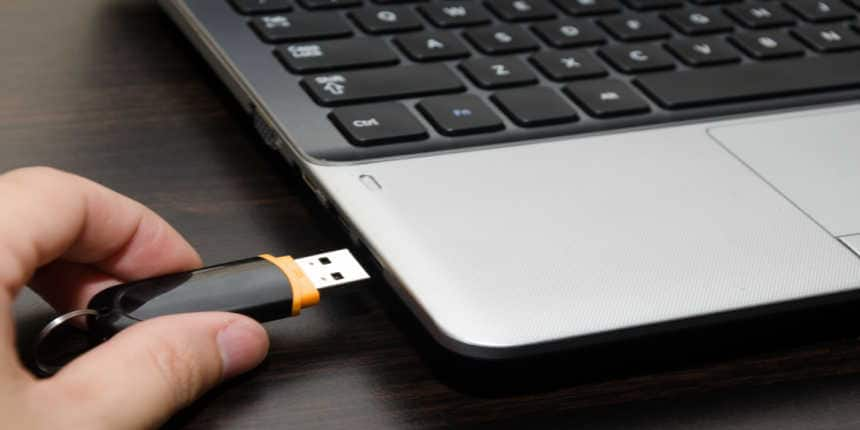USB Drive Full Form
What is the full form of USB Drive?
USB stands for “Universal Serial Bus." A USB drive is a storage device that is used to connect computers with other devices. This is used to connect a mouse, keyboard, scanner, printer, and other external devices. The USB drive is also used for file transfer, networking, contact, and power supply purposes between the devices. The common versions of USB are USB 1.0, USB 2.0, USB 3.0, USB 3.1.
- What is the full form of USB Drive?
- History of USB
- Characteristics of USB
- Advantages of USB
- Disadvantages of USB

The USB is widely used and accepted worldwide to transfer data from one location to another, and it also reduces the workload. It offers significant speed and many more advantages when compared to other devices.
History of USB
USB was first introduced in 1996 and developed by a number of companies like Intel Corporation, Microsoft Corporation, IBM (International Business Machines), etc. USB works on multiple platforms like Windows, Mac, Linux, etc. Before this technology, computers had one parallel port, one or two serial ports, and keyboard and mouse ports. The main purpose of this is to make the user comfortable when connecting the computer to other devices and to make the work easier. The need for USB emerged to solve the issues related to speed, i.e., the transfer of data between serial and parallel ports is very slow. The USB devices worked at a satisfactory speed and became a useful tool in the present day. There have been a number of revisions made to the USB drive since it was introduced, and each revision increased its connection speed compared to the older one.
Characteristics of USB
The main characteristics of USB are:
One single USB controller is used to connect nearly 127 peripheral devices.
USB 3.0 is used in modern computers which has a speed of 25 Megabits per second.
USB devices are based on the plug and play mechanism, which means these devices do not need any additional software to work on the computer.
Some of the USB devices also have power saving mode, that is the device will go into sleep mode when the computer is left in no use for a longer time.
The USB drive uses the power of the external devices like mouse, keyboard, etc. and there is no need for any external power to apply.
Advantages of USB
The major advantages of USB are:
This is less expensive when compared to other connecting devices.
As the USB uses plug and play mechanism, it is very easy to use.
Less power consumption
Each and every device containing the USB port fits in with the USB.
It uses a connector system which is robust.
The number of USB ports can also be increased with the help of USB hubs.
Disadvantages of USB
The disadvantages of USB are:
The performance of USB is limited.
It does not include the broadcast functionality.
Only a single message can be communicated between the computer and peripheral devices.
The length of these USB cables is limited.
Frequently Asked Questions (FAQs)
Based on their size, USB devices are classified into three types. They are:
Micro size USB
Mini size USB
Standard size USB
The connection of USB to a computer is very easy. First, we need to insert the USB drive into the USB port of the computer. Then the computer will automatically detect the device after inserting without any rebooting process. Here some of the devices come with the drivers and these are to be installed before using these devices. Then, after installing the drivers, the device starts working properly.
The USB drive is also called a “flash drive" because it uses flash memory as a memory device. The other names for this are “jump drive” or “thumb drive." This is mainly used to store digital data, and it is more robust and portable when compared to a hard drive.
USB was invented by “Ajay V. Bhatt." He is a computer architect in America who has developed various technologies like USB, chipset improvements, platform power management architecture, and many others. It was first used in 1996, when it replaced many of the serial and parallel ports.
The different USB standards are:
USB4: The speed of this version is 80 Gigabits per second.
USB4 2.0: USB4 supports 40 Gigabits per second..
USB 3.2 Gen 2x2: This is also known as “USB 3.2”. This device used to transfer the data at 20 Gigabits per second.
USB 3.2 Gen1: This is also known as “USB 3.1”. This device used to transfer the data at 10 Gigabits per second.
USB 3.2 Gen2: This is also known as “USB 3.0”. This device used to transfer the data at 5 Gigabits per second.
USB 2.0: The transmission rate of USB 2.0 is 480 Megabits per second.It is also called “High speed USB”.
USB USB 1.1: The transmission rate of USB 2.0 is 12 Megabits per second. This is also called “Full speed USB”.